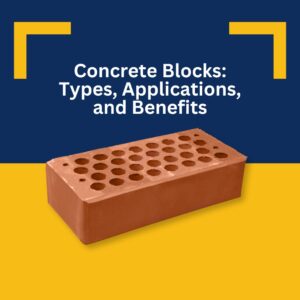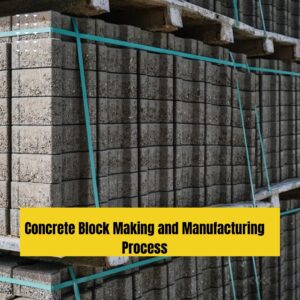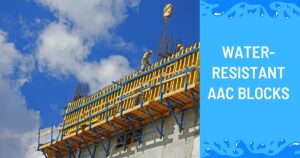Table of Contents
Autoclaved Aerated Concrete (AAC) blocks are widely used for construction and a more sustainable option compared to traditional brick types. Traditional bricks in the construction project are quickly being replaced by AAC blocks, also known as autoclaved aerated concrete blocks.
Among the Benefits of AAC blocks is their lightweight nature, thermal insulation properties, strength and durability, design flexibility, eco-friendliness, cost-effectiveness, Reduced Plastering, fire and earthquake resistance, faster construction, and healthier indoor environment.
Considering constructing or renovating your dream home or project? If so, you’ve probably come across a variety of building materials and methods. One option that has been acquiring significant attention is AAC (Autoclaved Aerated Concrete) blocks. Let’s delve into the numerous Benefits of Using AAC Blocks for your next construction project.
Building with AAC Blocks: Unleashing the Benefits
Lightweight Nature
(AAC) Autoclaved aerated concrete blocks, commonly known as AAC blocks, offer a notable advantage over traditional hollow blocks due to their lightweight nature, making them more convenient to handle and transport. Despite being lightweight, AAC blocks boast impressive durability, capable of withstanding significant weights while proving resilient against pests, mold, and fire hazards. Comparatively, AAC block weigh 33% less than red bricks, leading to potential savings of up to 20% in construction costs based on the project’s design, attributed to the reduced structural load they impose.
Thermal Insulation
AAC blocks have a distinct advantage due to their excellent thermal insulation. The innovative cellular structure effectively traps air, ensuring natural temperature regulation. This feature helps maintain internal warmth during cold spells and a cool environment in hot conditions, significantly cutting down on the building’s energy requirements. Moreover, this attribute not only enhances energy efficiency but also aligns with environment friendly practices.
Strength and Durability
AAC blocks are renowned for their exceptional compressive strength which enables them to effortlessly support heavy loads and resist external forces, ensuring the durability and stability of the building structure. Typically boasting a compressive strength ranging from 3-4 N/mm², AAC blocks outperform traditional clay brick, which typically have a lower strength of around 2.5 N/mm².
Design Flexibility
With AAC blocks, the ease of cutting and shaping them allows for effortless customization to cater to diverse architectural styles and design preferences. This flexibility presents a wide array of architectural opportunities for your project, enabling design flexibility and unique structures to come to life seamlessly.
Eco-Friendly
AAC blocks leverage construction material requiring minimal energy consumption in their manufacturing. Composed predominantly 70% fly ash, a byproduct typically considered waste, the manufacturing process stands out for its energy efficiency. This manufacturing method generates no pollutants, byproducts, or hazardous waste, making it an environmentally friendly option in the construction industry.
Cost-Effective
Although the initial cost of AAC block may be slightly higher than traditional bricks, benefits in terms of energy savings, durability, and reduced construction time make them a cost-effective choice in the long run. Reduced construction time, lower labor costs, energy efficiency, and minimal maintenance make AAC blocks a cost-effective choice.
Reduced Plastering Requirement
(AAC) Autoclaved aerated concrete blocks often require less plastering, further reducing construction costs. As a result, a thin layer of plaster is sufficient to build a wall using AAC blocks. Additionally, plastering cost savings can be approximately 35-40%.
Fire and Earthquake Resistance
AAC blocks are non-combustible, making them an excellent choice for fire resistant structures. It has a fire rating of 4 hours. Their density and lack of raw material deter pests, ensuring the longevity of your construction.
In addition to being fire resistance, AAC blocks are also earthquake resistant, with high durability against natural elements such as water and soil. This makes them an ideal choice for structures that need to withstand harsh environmental conditions. With their exceptional thermal insulation properties, AAC blocks provide a safe and sustainable building solution that is both fire resistant and earthquake resistant. It is more robust and tougher than regular building materials. As a result, AAC blocks have higher durability and can handle higher seismic activity and tremors compared to conventional building materials like clay bricks.
Sound Insulation
AAC blocks are highly effective at sound insulation thanks to their porous nature. The air pockets present in these blocks efficiently soak up sound waves, reducing noise transfer significantly. Additionally, their greater density in comparison to traditional materials like bricks and concrete allows them to offer top-notch sound-blocking properties.
Faster Construction
One key benefit of AAC blocks in construction is their facilitation of swift building processes. AAC blocks can easily be cut using straightforward tools such as drills and band saws due to their manageable and controllable nature. With the AAC block being nine times larger than traditional red clay brick, there are significantly fewer joints needed in the building’s framework. This reduction directly impacts the construction timeline, accelerating the overall progress. Additionally, the decreased necessity for extensive bricklaying work translates to expedited project completion. On the whole, integrating AAC blocks into construction projects can slash construction time by approximately 30%, enhancing efficiency and speed significantly.
Healthier Indoor Environment
AAC blocks do not emit any harmful gases or substances, contributing to a healthier indoor environment. This is especially important for residences and buildings where air quality matters. Incorporating AAC blocks into your construction project can offer a wide range of benefits, from energy efficiency to sustainability. As the construction industry continues to evolve, AAC blocks have proven to be a valuable and forward-thinking choice. So, if you’re looking for a building material that combines strength, energy efficiency, and eco-friendliness, Build Eco AAC Blocks might be the answer you’ve been searching for. Make your construction greener, safer, and more cost-effective with AAC blocks.
Frequently Asked Questions
(AAC) Autoclaved aerated concrete block stand out for their exceptional precision, durability, and flexibility, coupled with low breakage rates. These lightweight blocks provide superior insulation, making them ideal for ensuring optimal thermal regulation within homes, regardless of the prevailing weather conditions.
When integrating (AAC) Autoclaved aerated concrete block into construction projects, they prove to be excellent options for exterior walls and building foundations. Offering crucial support in constructing durable and sturdy buildings, it is essential to provide valuable insights on the seamless use of AAC blocks.
Conclusion
Nextblock is a leading provider of AAC (Autoclaved Aerated Concrete) blocks, offering a lightweight and eco-friendly construction material prized for its excellent thermal insulation, soundproofing capabilities, and resistance to fire. Our customer base comprises builders, contractors, architects, and individuals interested in sustainable and cost-effective building solutions. By upholding high standards, fostering innovation, and prioritizing customer satisfaction, we have established ourselves as a trusted and highly regarded entity in the construction industry.




